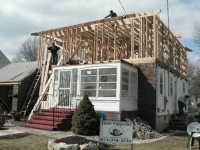Liberal America’s Single-Family Hypocrisy
spontaneous said:
Klinker said:This always seems to be the answer to how to provide housing for lower income people. Not addressing insane property tax rates, but instead building more higher density housing. Like poor people are arrogant for maybe wanting to be able to afford a modest single family house with a small yard for the kids to play in.
spontaneous said:Did I miss something? Who is talking about "forcing" it on people?
Apartment living, and city living, are both fine for people who choose it. Forcing it on people, however, is not cool.
The article is specifically talking about San Francisco where even the middle class can't find housing. That's not because of property taxes which are pretty low in CA, its because there literally isn't anymore land to build on. If you want to build a single family house with a small yard its going to be somewhere out by Stockton and you are going to be facing a 4 hour commute (each way).
There are plenty of very rich people living in fairly dense high rises just a a couple of stops down the train line from here.
Klinker said:
The denser the population the smaller the foot print.
As currently implemented.
If everyone was allotted energy usage/carbon footprint limits, the carbon footprint would decrease in less dense areas.
sprout said:
Klinker said:As currently implemented.
The denser the population the smaller the foot print.
If everyone was allotted energy usage/carbon footprint limits, the carbon footprint would decrease in less dense areas.
But still be higher. The costs of transportation and distribution guarantee that.
Klinker said:
sprout said:But still be higher.
Klinker said:As currently implemented.
The denser the population the smaller the foot print.
If everyone was allotted energy usage/carbon footprint limits, the carbon footprint would decrease in less dense areas.
Not necessarily. You have more space for solar panels, more space for storing human-powered energy and travel implements (bicycles),...
So, give those in larger spaces a luxury tax of a lower energy usage/carbon footprint limit than those in higher density areas. It's likely to increase energy and conservation creativity.
sprout said:
Klinker said:Not necessarily. You have more space for solar panels, more space for storing human-powered energy and travel implements (bicycles),...
sprout said:But still be higher.
Klinker said:As currently implemented.
The denser the population the smaller the foot print.
If everyone was allotted energy usage/carbon footprint limits, the carbon footprint would decrease in less dense areas.
So, give those in larger spaces a luxury tax of a lower energy usage/carbon footprint limit than those in higher density areas. It's likely to increase energy and conservation creativity.
Food and goods you buy have to be transported greater distances plus you lose a fair amount of efficiency with small generation solar which drives up the per kw carbon cost from manufacturing.
Klinker said:Food and goods you buy have to be transported greater distances plus you lose a fair amount of efficiency with small generation solar which drives up the per kw carbon cost from manufacturing.
So, count this when calculating energy footprint limits:
It probably makes more of a difference in carbon footprint if one eats a meat diet vs. a vegetarian diet.
It could encourage eating more local foods vs. winter fruit from South America. It could encourage less food waste, and less container waste.
I forgot to address the solar: I've tasked my 11 yr old daughter with inventing a nearly perfect efficiency (and low volatility) energy storage mechanism when she gets older. I'm hoping for minimal loss of efficiency in small solar/wind applications in the not too-distant future. But you are correct, we are not there yet.
Klinker said:
Did I miss something? Who is talking about "forcing" it on people?
it's the exact opposite of forcing people. The point of the article is that lots and lots of people WANT to move to cities, but zoning ordinances are preventing the construction of more housing units.
ml1 said:
Klinker said:it's the exact opposite of forcing people. The point of the article is that lots and lots of people WANT to move to cities, but zoning ordinances are preventing the construction of more housing units.
Did I miss something? Who is talking about "forcing" it on people?
Wouldn't it be more efficient to incentivize renewal of cities that already exist, but are being abandoned due to limited employment opportunities, than to try to increase the density of cities that currently have the most financial clout -- but may end up less viable as the oceans rise?
sprout said:
Klinker said:So, count this when calculating energy footprint limits:Food and goods you buy have to be transported greater distances plus you lose a fair amount of efficiency with small generation solar which drives up the per kw carbon cost from manufacturing.
It probably makes more of a difference in carbon footprint if one eats a meat diet vs. a vegetarian diet.
It could encourage eating more local foods vs. winter fruit from South America. It could encourage less food waste, and less container waste.
A vegetarian diet is usually rich in carbs which frequently causes flatulence (sigh, another green-house gas).
ml1 said:
Klinker said:it's the exact opposite of forcing people. The point of the article is that lots and lots of people WANT to move to cities, but zoning ordinances are preventing the construction of more housing units.
Did I miss something? Who is talking about "forcing" it on people?
Are you alleging that the zoning ordinances of many cities regarding density do NOT reflect the will of the majority of that city's voters?
proeasdf said:
Are you alleging that the zoning ordinances of many cities regarding density do NOT reflect the will of the majority of that city's voters?
Why would you even ask that?
proeasdf said:
Are you alleging that the zoning ordinances of many cities regarding density do NOT reflect the will of the majority of that city's voters?
I would say that's true in some places. In many cities, there's a lot of enthusiasm for allowing accessory dwelling units (garage apartments, etc.) and duplexes, especially in close-in neighborhoods, as a low-impact way of increasing density, providing affordable ("missing-middle") housing, and helping homeowners with onerous taxes. Those kind of arrangements were common until communities started implementing exclusionary zoning* and single-family houses became the norm.
I own and live in a two-family house myself. This allows me to live in a town that would otherwise be beyond my means, and I provide a modest apartment to a young couple who couldn't afford the luxury buildings in town. Seems to me this is a good thing, but what happens when additional multi-family housing is proposed? Outrage. The whole point of current zoning is to prevent undesirables (like me) from moving to town, and it's very effective.
I've gotten really fed up with the I've-got-mine attitude in these wealthy NJ towns. The same question keeps running through my head: "Where are your kids going to live?" You may think you are preserving your property values, but what are we leaving the next generation?
------------------------------
* Exclusionary zoning is the use of zoning ordinances to exclude certain types of land uses from a given community. As of the 2010s, exclusionary zoning ordinances are standard in almost all communities. Exclusionary zoning was introduced in the early 1900s, typically to prevent racial and ethnic minorities from moving into middle- and upper-class neighborhoods. Municipalities use zoning to limit the supply of available housing units, such as by prohibiting multi-family residential dwellings or setting minimum lot size requirements. These ordinances raise costs, making it less likely that lower-income groups will move in. Development fees for variance (land use), a building permit, a certificate of occupancy, a filing (legal) cost, special permits and planned-unit development applications for new housing also raise prices to levels inaccessible for lower income people.
Exclusionary zoning is done to safeguard the individual's property value, reduce traffic congestion, and exclude unalike groups. Exclusionary land-use policies exacerbate social segregation by deterring any racial and economic integration, decrease the total housing supply of a region and raise housing prices. As well, regions with much economic segregation channel lower income students into lower performing schools thereby prompting educational achievement differences. A comprehensive survey in 2008 found that over 80% of United States jurisdictions imposed minimum lot size requirements of some kind on their inhabitants. These ordinances continue to reinforce discriminatory housing practices throughout the United States.
mjc said:
Tom, thanks for this link! Very interesting and rings true (though I didn't follow the opposing link in the Comments).
I was not aware of the widespread "downzoning" decades ago, e.g.: "Los Angeles went from being zoned to accommodate 10 million people in 1960 to 4.3 million in 2010." !!
Well, LA also had a functioning mass transit system until around 1960.
Here’s an interesting opinion piece from today’s NYT on the topic of this thread.
Sweetsnuggles said:
Here’s an interesting opinion piece from today’s NYT on the topic of this thread.
https://www.nytimes.com/2019/05/22/opinion/california-housing-nimby.html?action=click&module=Opinion&pgtype=Homepage
Saw that. This was my favorite part:
What Republicans want to do with I.C.E. and border walls, wealthy progressive Democrats are doing with zoning and Nimbyism. Preserving “local character,” maintaining “local control,” keeping housing scarce and inaccessible — the goals of both sides are really the same: to keep people out.
“We’re saying we welcome immigration, we welcome refugees, we welcome outsiders — but you’ve got to have a $2 million entrance fee to live here,
my only quibble with that article is that rich Democrats should not be referred to as "liberals", because they aren't. They are pretty conservative when it comes to economic issues.
kthnry said:
That part also got my attention. Sometimes the reflection in the mirror isn’t flattering.
ml1 said:
my only quibble with that article is that rich Democrats should not be referred to as "liberals", because they aren't. They are pretty conservative when it comes to economic issues.
Lots of folks vote to the left on economic issues except when it comes to their localities. So you or I might be someone who is liberal all the way except when it comes to our neighborhood. So call me liberal or conservative; maybe the label isn't very helpful.
Tom_Reingold said:
ml1 said:Lots of folks vote to the left on economic issues except when it comes to their localities. So you or I might be someone who is liberal all the way except when it comes to our neighborhood. So call me liberal or conservative; maybe the label isn't very helpful.
my only quibble with that article is that rich Democrats should not be referred to as "liberals", because they aren't. They are pretty conservative when it comes to economic issues.
The whole dualism between the labels "liberal" and "conservative" hasn't been relevant in our political culture for at least a generation.
it was just pointed out to me that an earlier post of mine might belong here as well — a trifecta story!
https://www.nytimes.com/2019/05/22/opinion/california-housing-nimby.html
mtierney said:
it was just pointed out to me that an earlier post of mine might belong here as well — a trifecta story!
https://www.nytimes.com/2019/05/22/opinion/california-housing-nimby.html
And …
It always is a good idea to read the thread.
Previously on this thread ...
Sweetsnuggles said:
Here’s an interesting opinion piece from today’s NYT on the topic of this thread.
https://www.nytimes.com/2019/05/22/opinion/california-housing-nimby.html?action=click&module=Opinion&pgtype=Homepage
weirdbeard said:
The whole dualism between the labels "liberal" and "conservative" hasn't been relevant in our political culture for at least a generation.
It shows how labels, in general, aren't so great.
I lived in Maplewood for 10 years. It's a place where many people take pride in their liberalism. But people make comments about unusual behavior.
Not that I'm any better.
Tom_Reingold said:
It shows how labels, in general, aren't so great.
I lived in Maplewood for 10 years. It's a place where many people take pride in their liberalism. But people make comments about unusual behavior.
Not that I'm any better.
The majority of people here in Maplewood are not that liberal. I meet a lot of people and when it gets to talking politics, I'm to the left of almost everyone, even the Democrats. People are very left-leaning on social issues, but on economic issues, many are pretty conservative. How many Maplewoodians are very supportive of unions, or in favor of "Medicare for all", free public college, or the Green New Deal? From my experience, it's a minority.
Allowing a lot more people to live in the places with the most jobs, educational opportunities, and transportation options will reduce segregation and inequality, enable more people to live an environmentally friendly lifestyle, and create the kind of homes that conform to current demographic realities.
I think someone just made this up, or they have never been to New York City or Chicago or Boston or Baltimore or most of the major cities in America.
In most of the major city in America there are huge areas of abject poverty that are easily accessible to jobs, educational opportunities and transportation options. And it didnt reduce segregation and inequality or enable more people to live an environmentally friendly lifestyle. I live in St Petersburg and the poorest areas are walking distance from where the jobs are. High density buildings are also much more expensive to maintain than low density buildings.
Building more housing is a necessary part of any solution, but very far from sufficient. "More housing" is relative and context-specific -- it doesn't really make sense to bring up places like Manhattan or the Bronx when talking about places like Maplewood or South Orange, as those are clearly very different contexts.
The push for upzoning comes, not from any magical properties of density, but from the fact that the most opportunities are concentrated in our major metro areas, and so the question is how to keep access to these opportunities open to a broad range of people. As long as our metro areas continue to grow, I think its a pretty straightforward observation that if housing availability doesn't grow alongside then we're making a choice to lock up access to opportunity to those already here and exclude anyone new.
That's just the bare minimum though. Segregation, for instance, is about much more than housing availability -- as sarahzm notes, there are plenty of neighborhoods in our metro areas that are physically close to job and education opportunities yet are very poor. We can see that close to home right here, where Newark, Orange, and East Orange border SOMA.
On this broader issue of how well off communities fight inclusion, I found this to be a good read:
https://www.citylab.com/equity/2019/05/connecticut-affordable-housing-zoning-westport/590155/
(Citylab in general I find to be a good site for those interested in these kinds of issues)
Relevant story in NYT:
Cities Start to Question an American Ideal: A House With a Yard on Every Lot
Has some interesting data visualizations on how much of different cities are zoned exclusively for single family homes. NYC is an outlier at 15%, but nationwide it's closer to 75%, with some in the South and West being north of 80%.
Sponsored Business
Promote your business here - Businesses get highlighted throughout the site and you can add a deal.
Featured Events
-
Stephen Whitty Presents - Hometown Movie Stars: The Celebrated Actors Of CHS
May 6, 2024 at 7:00pm





































This always seems to be the answer to how to provide housing for lower income people. Not addressing insane property tax rates, but instead building more higher density housing. Like poor people are arrogant for maybe wanting to be able to afford a modest single family house with a small yard for the kids to play in.